Create a messy garden for nature
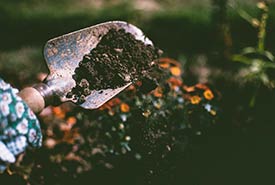
Gardening is a great way to connect with nature (Photo by Lisa via Pexels)
As the warmer weather rolls across the country, many people have started tidying their garden for spring planting. But did you know that by leaving some of the stems and stalks that we traditionally clean up in the spring, you can create habitat for insects and wildlife?
Take this quiz to test your knowledge on spring gardening
This past December, I convinced my husband to save the Christmas tree from the curb, and instead toss it in the backyard. Fast forward to last weekend; we’ve finally gone into our backyard to begin readying our garden for all the vegetables and flowers we hope to start planting.
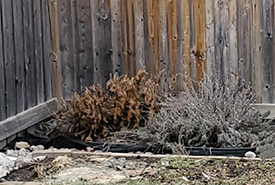
Our Christmas tree in a corner beside an unruly lavender shrub planted by the house's previous owners. (Photo by Wendy Ho/NCC staff)
My job is relatively easy, as I’ve committed myself to maintaining and expanding the selection of native plants in our yard. I was delighted to see that not only had the old Christmas tree dropped half of its needles, it had blanketed a patch of soil in much the same way groundcover blankets a forested area. And the tree still smells amazing! I can’t wait to see the branches break down and enrich the soil over the next year or two.
This small tree of ours is also continuing to spread cheer and pique the curiosity of my toddler and preschooler. Seeing the tree’s transformation will give rise to many opportunities to talk to them about how nature recycles trees.
If you too are heading back outside for some gardening, here are some ways to help support the biodiversity in your yard:
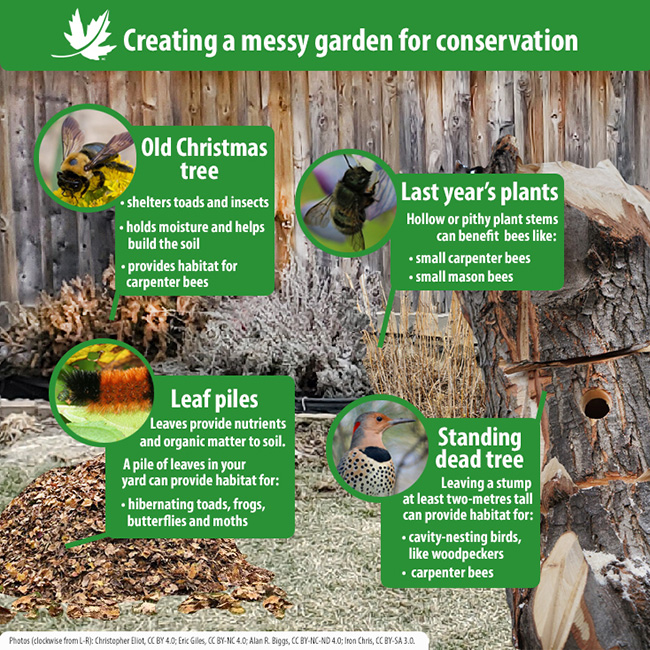
Photos (clockwise from left to right): Christopher Eliot CC BY 4.0, Eric Giles CC BY-NC 4.0, Alan Biggs CC BY-NC-ND 4.0, Iron Chris CC BY-SA 3.0 (Graphic by NCC)
An old Christmas tree keeps on giving
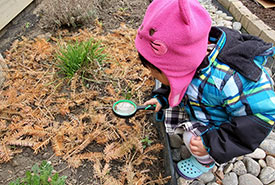
My toddler inspecting the branches and needles I've scattered around the wild nodding onion plant. (Photo by Wendy Ho/NCC staff)
By leaving your old Christmas tree in the yard propped against a fence or lying on the ground, you provide shelter for insects and toads. In spring, some of the needles will have dropped and you can trim the branches and thinly spread them over the garden before the plants and flowers start to emerge. The branches and remaining needles help hold moisture and build the soil as they break down. Thicker branches and the trunk can even provide habitat for carpenter bees (large bees that look like bumble bees), as they like to tunnel in wood.
Dormant or dead stalks can be natural bee hotels
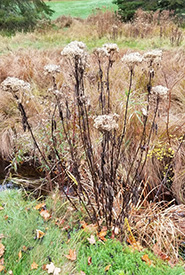
Spotted Joe pye-weed (Photo by sturgus, CC BY-NC 4.0)
Plants with hollow or pithy stems, such as coneflower and Joe pye-weed, can attract small mason or carpenter bees to nest in them. In spring, trim the stalks to varying heights, between 20 and 60 centimetres. Female bees will lay an egg on a pollen ball placed inside the stem so the hatched larvae can feed on the pollen.
Don’t rake (all of) your leaves
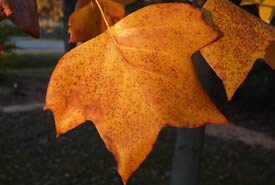
Tuliptree leaf in fall (Photo by Bernt Solymar)
You may have read the Nature Conservancy of Canada’s suggestion this past fall that encouraged homeowners to leave the leaves. Leaf piles are a refuge for overwintering insects and hibernating toads, frogs, butterflies and moths. For example, silver-spotted skippers hibernate in chrysalis form in leaf litter. Other species of butterflies, like Baltimore checkerspot, hibernate as caterpillars in the leaves and emerge in spring to continue feeding.
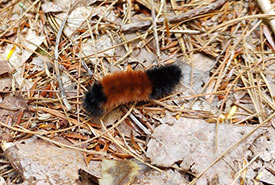
Woolly bear caterpillar (Photo by Noah Brian Johnson, CC BY-NC 4.0)
Another recognizable leaf litter dweller is woolly bear caterpillar. They hide under leaves over the winter and spin a cocoon in spring, later emerging as an Isabella tiger moth. Similarly, the magnificent luna moth hibernates in cocoon stage in fall leaves and graces our yards come spring. Leaving the fallen leaves provides natural mulch and helps build and fertilize the soil. A thick pile of leaves can impact the growth of grass and other plants, but a thin layer can improve the overall health of the garden. Insects that overwinter in leaf piles are also an important food source for songbirds, like blue jays and chickadees.
Save that stump
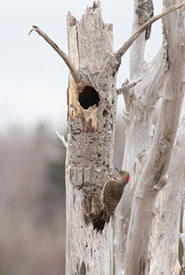
Northern flicker (Photo by David McCorquodale, CC BY 4.0)
If you have a tree stump in your yard, whether it was inherited from previous owners or from a tree blown over in a storm, you might want to reconsider removing it. Dead wood can provide valuable habitat for cavity-nesting birds, like norther flickers and woodpeckers. If it’s large enough, drilling various-sized holes can encourage wood-nesting bees as well. Watch this video from Ontario Parks about how a flicker family became tenants of an unassuming tree stump.


